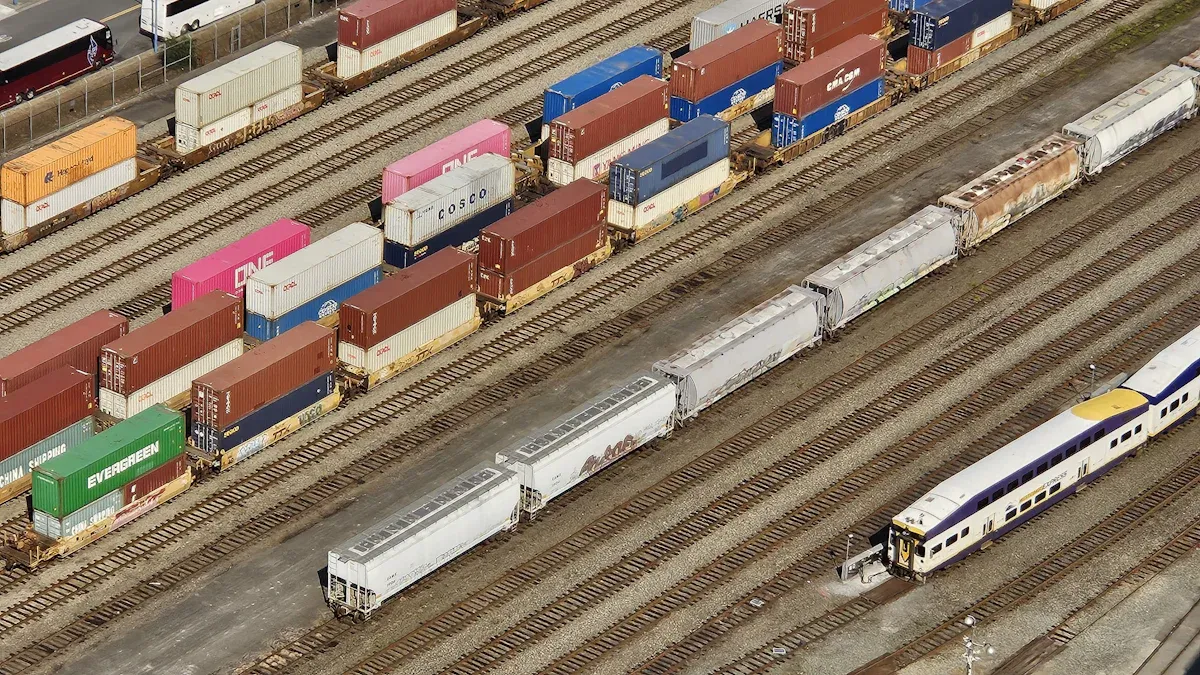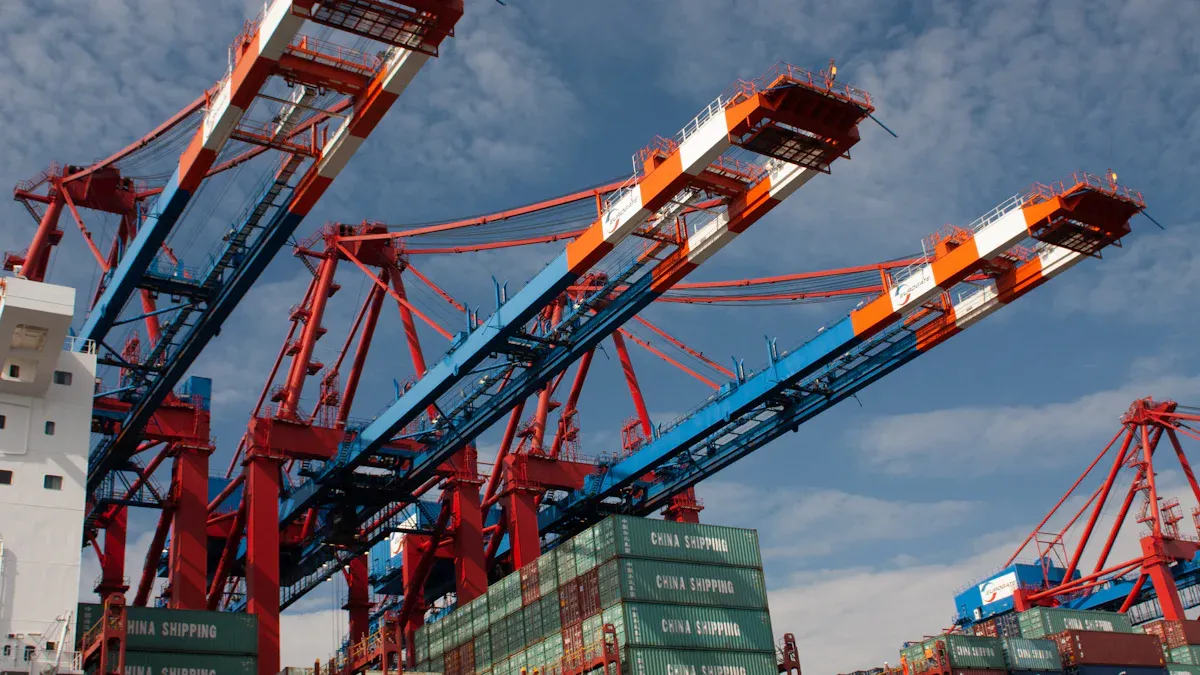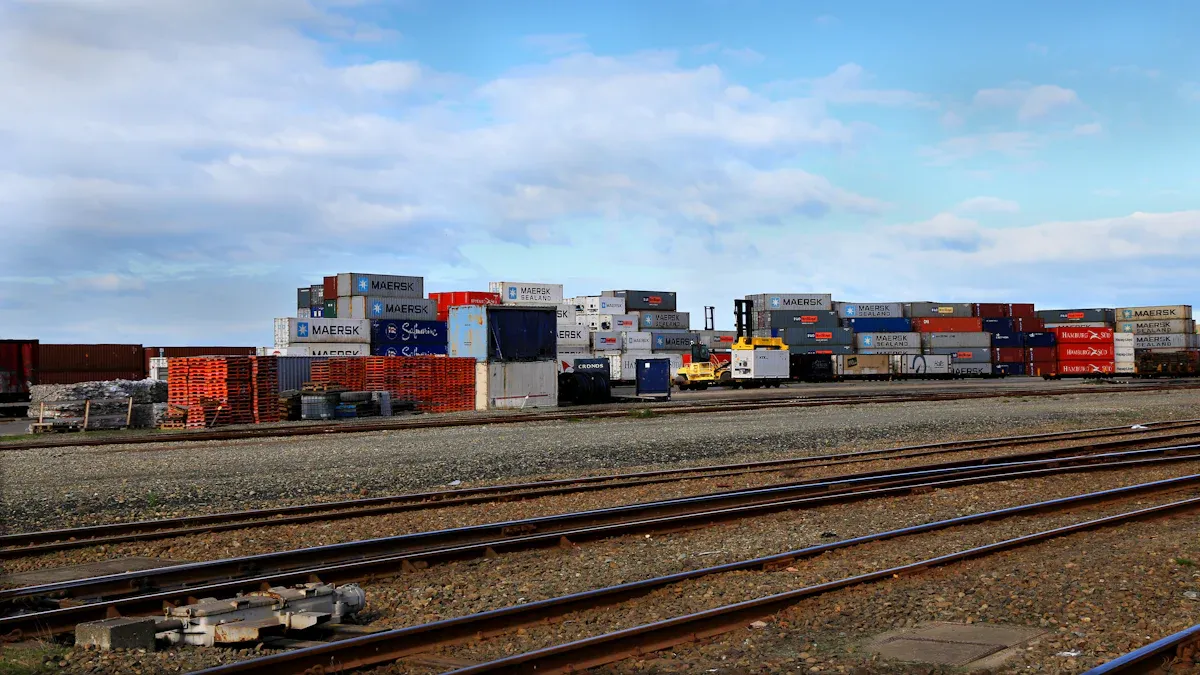Will China-Europe Railways Replace Air Freight?

China-Europe railways have revolutionized global trade by offering a practical alternative to air freight. These rail networks, like JUSDA's China-Europe Express Rail, provide a middle ground between cost and speed. For instance, rail transport costs are about 30% lower than air freight, making it an attractive option for businesses. Additionally, the average transit time of 12-16 days ensures faster delivery compared to sea shipping. Since 2011, the cargo volume on these routes has surged, reflecting their growing importance in connecting China and Europe. This shift highlights the evolving role of rail in modern logistics.
Key Takeaways
China-Europe trains can save up to 30% compared to planes. This makes them a good option for companies.
Trains are better for the environment. They create less pollution and help with green shipping.
Railways can carry big loads easily. They are great for items like electronics and clothes.
Planes are still the quickest for urgent shipping. They take 3-5 days, while trains take 14-16 days.
Using both trains and planes can save money and time. This helps meet different shipping needs.
Advantages of China-Europe Railways

Cost-Effectiveness of China-Europe Railways
China-Europe railways provide a cost-efficient solution for businesses seeking an alternative route to ocean and air services. Rail transport costs are significantly lower than air freight, offering savings of up to 30%. For example, a Chinese manufacturer reduced transport costs by 30% while cutting delivery times from 45 to 20 days. This balance between cost and speed makes rail an attractive option for companies transporting goods from China to Europe.
The cost advantages become even more evident when analyzing longer trains and shorter transit times. Studies show that generalized chain costs can decrease by up to 25% with these optimizations. Rail transport also proves more efficient than maritime and air services for specific cargo types, further solidifying its role as a cost-effective logistics solution.
Environmental Benefits of Rail Transport
Rail transport stands out as an environmentally friendly option compared to air and sea freight. It produces significantly lower carbon emissions, making it a sustainable choice for businesses. A study on urban rail transit in Beijing highlighted its effectiveness in reducing emissions and alleviating traffic congestion during peak hours. These findings emphasize the ecological benefits of rail systems.
The China-Europe railways contribute to global sustainability efforts by offering a greener alternative for transporting goods. Lower emissions and reduced reliance on fossil fuels align with the growing demand for eco-conscious logistics solutions. By choosing rail, you can minimize your environmental footprint while maintaining efficient operations.
Capacity for Large Shipments on China-Europe Routes
China-Europe railways excel in handling large shipments, making them a reliable option for businesses with high-volume cargo needs. In 2021, the average train load increased to 117 TEU, marking a 37.6% rise over six years. The total freight volume along the Eurasian railway route reached 693,000 TEUs in the same year, a sixfold increase since 2016.
This capacity growth demonstrates the efficiency of rail transport in managing substantial cargo volumes. Whether you need to move electronics, clothing, or medical supplies, the China-Europe railways offer a dependable solution. Their ability to handle diverse goods ensures that your shipments reach their destination without delays or complications.
Limitations of China-Europe Railways
Slower Transit Times Compared to Air Freight
When time is critical, air freight outperforms rail transport. Air freight typically delivers goods within 3 to 5 days, while rail transport takes 14 to 16 days on average. This difference makes air freight the preferred choice for urgent shipments, such as medical supplies or high-value electronics. Although rail offers a balance between cost and speed, it cannot match the efficiency of air freight for time-sensitive deliveries. Businesses must weigh these factors when choosing the best logistics solution for their needs.
Limited Network Reach in Europe
The China-Europe rail network faces challenges in reaching key destinations within Europe. Many trains stop in countries like Russia, part of the Eurasian Economic Union (EAEU), rather than directly entering European Union (EU) nations. This limited reach creates gaps in the network, making it less accessible for businesses in Western Europe. Expanding the network to cover more EU countries would improve its utility, but this requires significant investment and coordination among multiple nations.
Infrastructure Challenges in Expanding Rail Networks
Expanding rail infrastructure for China-Europe routes presents several hurdles. Many European countries rely on outdated technologies, which reduce transportation efficiency. Technical inconsistencies, such as incompatible rail gauges, further complicate operations. Additionally, customs procedures vary across countries, leading to delays and higher costs. Geopolitical tensions also hinder cross-border collaboration, making it difficult to streamline operations. While rail transport is generally more eco-friendly than other modes, it still has environmental impacts that must be addressed. Overcoming these challenges requires modernizing infrastructure and harmonizing regulations across regions.
Advantages of Air Freight
Speed and Efficiency for Time-Sensitive Goods
Air freight is the fastest way to transport goods, making it the preferred mode of transport for urgent shipments. You can rely on air freight to deliver goods globally within hours or days, a speed unmatched by other methods. Airlines operate on strict schedules, offering multiple daily flights that minimize delays and ensure reliability. This efficiency is crucial for industries that depend on timely deliveries, such as medical supplies or high-value electronics. For example, vaccines and other life-saving medicines often rely on air freight to reach their destinations quickly, preserving lives and maintaining global health standards.
✈️ Tip: If your business requires rapid delivery, air freight ensures your goods arrive on time, no matter the destination.
Global Reach Beyond China to Europe
Air freight connects the world like no other mode of transport. It provides access to remote and landlocked regions, enabling countries to participate in global trade. For shipments between China and Europe, air freight offers unparalleled flexibility. Major routes, such as Chongqing to Duisburg, handle significant trade volumes, ensuring goods move efficiently across continents. This global network supports e-commerce growth by facilitating quick deliveries, helping businesses expand their reach. Whether you’re shipping to a bustling city or a remote village, air freight ensures your products get there.
Key Benefits of Air Freight’s Global Reach:
Enhanced collaboration between economies through faster trade.
Support for international market expansion and productivity.
Suitability for High-Value and Perishable Goods
Air freight is the preferred mode of transport for high-value and perishable goods. Items like luxury electronics, fresh flowers, and medical supplies require careful handling and quick delivery. Air freight ensures these goods reach their destination in perfect condition. For instance, perishable foods and flowers benefit from the speed of air transport, maintaining their freshness. Similarly, high-value products like jewelry and designer clothing rely on air freight for secure and timely delivery. The growing demand for air freight services reflects its importance in handling these specialized shipments.
🌍 Note: The air freight market is projected to grow significantly, highlighting its role in transporting high-value and time-sensitive goods.
Comparative Analysis of China-Europe Railways and Air Freight

Cost vs. Speed in Logistics
When comparing cost and speed, you must consider the trade-offs between rail and air transport. Air freight delivers goods in just 3-5 days, making it the fastest option for time-sensitive shipments. In contrast, china-europe railways take 14-16 days, offering a middle ground between air and sea transport. While rail cannot match the speed of air freight, it provides significant cost savings. Businesses using rail can reduce logistics expenses by up to 25%, especially for high-value cargo.
Transport Mode | Transit Time (Days) | Cost Reduction (%) |
|---|---|---|
Air | 3-5 | N/A |
Rail | 14-16 | Up to 25% |
Sea | 30-34 | N/A |
For companies relying on just-in-time logistics, rail offers a competitive alternative to sea freight. It balances cost and speed, helping you optimize cash flow while ensuring timely delivery.
Environmental Impact of Rail vs. Air Transport
Rail transport stands out as a more sustainable option compared to air freight. Airplanes emit significantly higher levels of carbon dioxide, contributing to environmental degradation. In contrast, china-europe railways produce fewer emissions, aligning with global efforts to reduce the carbon footprint of logistics operations. By choosing rail, you can support eco-friendly practices while maintaining efficient cargo movement.
Additionally, rail systems rely less on fossil fuels, further enhancing their environmental benefits. This makes rail transport an ideal choice for businesses prioritizing sustainability in their supply chains.
Suitability for Different Types of Goods
The suitability of rail and air freight depends on the type of cargo you need to transport. Air freight excels in handling high-value and perishable goods, such as luxury electronics or fresh produce. Its speed ensures these items reach their destination in perfect condition. On the other hand, rail is better suited for bulk shipments and durable goods like household items or raw materials.
Cargo Type | Rail Transport Cost | Air Transport Cost | Maritime Transport Cost |
|---|---|---|---|
High-tech Goods | Highest | More than 3 times | 1.5 times higher |
Household Goods | Approximately same | N/A | N/A |
Raw Materials | Approximately same | N/A | N/A |
China-europe railways also cater to industries like mining, chemicals, and logistics, which account for a significant share of rail freight demand. Whether you need to move electronics or bulk materials, understanding the strengths of each mode helps you make informed decisions.
Complementary Roles in Global Supply Chains
Rail and air freight play distinct yet complementary roles in global supply chains. Each mode offers unique advantages, and combining them can create a more efficient and resilient logistics network. You can leverage this synergy to optimize costs, improve delivery times, and enhance supply chain flexibility.
Rail freight excels in transporting bulk goods over long distances. It provides a cost-effective solution for industries like electronics, automotive, and manufacturing. For instance, the China-Europe Railway Express has helped a major electronics manufacturer in Shenzhen reduce its reliance on air freight. By using rail for components and finished products, the company achieved significant cost savings while maintaining supply chain resilience. This example highlights how rail can complement air freight by handling less time-sensitive shipments.
Air freight, on the other hand, ensures the rapid and secure movement of goods across the globe. It is indispensable for industries requiring fast delivery, such as pharmaceuticals and high-value electronics. The ongoing training and certification of air freight professionals enhance the safety and efficiency of this mode, making it a reliable choice for urgent shipments. When paired with rail, air freight can handle time-critical goods while rail manages bulkier, less urgent cargo.
Multimodal logistics, which combines rail with other modes like air and sea, is gaining popularity. Approximately 22% of global freight transportation now uses this approach. The rise of e-commerce has driven this trend, as businesses seek faster and more reliable delivery options. Rail and air freight together meet these demands by balancing speed, cost, and capacity.
By integrating rail and air freight into your supply chain, you can adapt to changing market needs. This combination allows you to capitalize on the strengths of both modes, ensuring a seamless and efficient logistics operation.
China-Europe railways, like JUSDA's China-Europe Express Rail, offer a practical balance between cost and speed. Rail transport costs less than air freight, with savings of up to 25% when optimized. While air freight delivers goods in 3-5 days, rail takes 14-16 days, making it ideal for less urgent shipments. Both modes serve unique roles in global trade. You can use rail for cost-effective bulk shipments and air for time-sensitive goods. Together, they create a flexible logistics network that adapts to evolving trade demands between China and Europe.
FAQ
What types of goods are best suited for China-Europe railways?
China-Europe railways work well for durable goods like electronics, clothing, and medical supplies. These items benefit from the balance of cost and speed. Rail transport also supports bulk shipments, making it ideal for industries like automotive, manufacturing, and FMCG.
🚂 Tip: Use rail for goods that don’t require urgent delivery.
How does the cost of rail compare to air freight?
Rail transport costs about one-fifth of air freight. This makes it a cost-effective option for businesses looking to optimize logistics expenses. For example, you can save up to 30% on transportation costs by choosing rail over air.
💡 Note: Rail offers a middle ground between cost and speed.
Can rail transport handle time-sensitive shipments?
Rail transport is not ideal for urgent shipments. It takes 14-16 days on average, compared to 3-5 days for air freight. However, it works well for moderately time-sensitive goods that don’t require immediate delivery.
⏱️ Reminder: Choose air freight for critical, time-sensitive deliveries.
Is rail transport environmentally friendly?
Yes, rail transport produces significantly fewer carbon emissions than air freight. It relies less on fossil fuels, making it a sustainable choice for businesses. By using rail, you can reduce your environmental footprint while maintaining efficient operations.
🌍 Eco-Friendly Choice: Rail aligns with global sustainability goals.
How reliable is the China-Europe Express Rail?
The China-Europe Express Rail offers reliable service with a transit time of 15-20 days. JUSDA ensures smooth customs operations and resource alignment, minimizing delays. Its extensive network supports consistent and dependable delivery.
✅ Reliability: Trust rail for steady and predictable logistics.
See Also
Discovering Innovations in Sea Freight Logistics for 2024
An In-Depth Look at the Future of LTL Freight
Preparing for the Upcoming Revolution in Transport Technology
Get Prepared: The Latest Innovations in Supply Chain Technology
Navigating Future Logistics Through Advanced Digital Technologies
